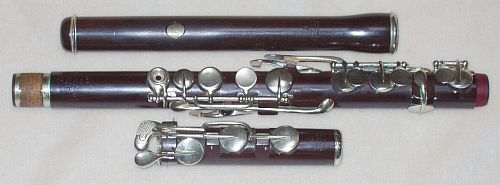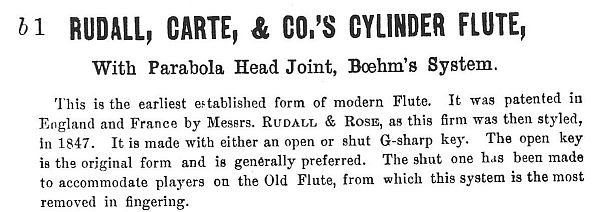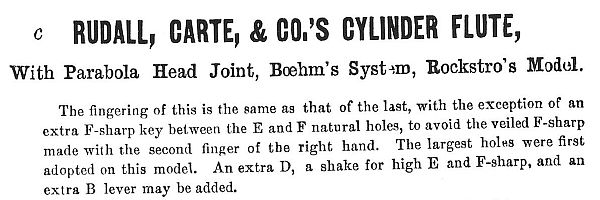

Boehm had been impressed with the English virtuoso Charles Nicholson's tone and power, and was in part motivated to design his new flute(s) so that Nicholson's sound could be made available to others who could not handle the difficulties of the Nicholson-style flutes. So it is no surprise that the English immediately appreciated the tone and power of Boehm's flutes.
But many English players had no patience for the change in fingering necessitated by Boehm's design. The open G# key certainly would have been a major complaint, as well as the loss of the F# fingering (1234--k) of the simple system flute. Most of the objections were because players had learned on and were used to, and comfortable with, the old system, not because of any actual superiority. But there certainly were musical passages where the old fingering really was, in an objective sense, easier or better. And we have earlier noted Rockstro's remark that "The old flute, with eight keys and upwards, possesses certain facilities in the fingering of the third octave which are not afforded by any flutes on the open-keyed system [e.g. the Boehm flute]..."
The power, and the tonal evenness, of the Boehm flutes (more power on the cylindrical model) is due to the large, evenly spaced tone holes and the "full venting" (avoidance of veiled forked fingerings) available with open-standing keys. This was immediately recognized—and had, of course, been understood well before Boehm did his work.
A number of English players and inventors tried either (1) to combine most or all of the old fingering with the new bores and hole sizes used on Boehm flutes, while keeping most or all closed-standing keys, or (2) to "improve" the Boehm flute fingering, by incorporating some of all of the old flute's fingerings, while adhering to the open-standing key principle. Flutes of type (1) I sometimes call "modified simple system" flutes, and those of type (2) I tend to call "hybrid system" flutes; but these or any other terms can be misleading. The Rudall Carte firm used the term "modern flutes" for cylindrical bore flutes with large holes. Rocktro in one instance speaks of "psuedo-old" flutes; see below. Actually, "hybrid system" may describe type (1) well, because these instruments have both open and closed-standing keys.
Many inventors helped themselves to parts of the Boehm mechanism, like axles and ring keys, but these ideas existed before Boehm anyway.
These efforts to combine aspects of both systems are fascinating. Extreme cleverness was called into play, with positive results in many cases, appreciated and used by many. The Carte 1867 System flute may actually be better than the Boehm flute. It was "the only important and lasting modification of the Boehm flute", according to Adam Carse. It still had a number of British professional players in the 1960s. The 1867 model did fail to become the world standard flute, but, while standards can be useful, remember that what becomes the standard is not always the best or ideal (some may wish to think of e.g. computer operating systems at this point).
Still, one must admire Boehm's system (as he originally designed it—including the open G#, in particular). His goal of simplicity of mechanism was achieved about as well as can be imagined. Some of the hybrid system mechanisms are quite complex.
Because of the colorful story of these modified and hybrid systems, there is a tendancy for some books on flute history, in particular the older English language books, to give a mistaken impression of the importance of these English systems. They are important; they certainly influenced thinking elsewhere. But they were only really popular in England and some English speaking countries. In 1889, Rockstro wrote
In justice to the consistency of our Continental neighbours it should be mentioned that while we [the English] have been too prone to vacillation between the old, the new, and the psuedo-old systems, the French have been generally loyal to the [Boehm flute]..., and the Germans have, with equal pertinacity, adhered to the old flute, pure and simple.
So if one is more interested in French or German flute music from 1889, perhaps one should spend more of one's effort on understanding the Boehm flute or the old flute, respectively, as made and played at that time.
An early effort to combine the old system and Boehm was made by Cornelius Ward, but his flute is largely forgotten. The most successful English designs were
The first three are still based primarily on closed keys for the notes outside D major, and so I think of them as modifications of the simple system even though there are open standing keys or ring keys for some of what would be the six open finger holes.
The top photo on this page shows a cylindrical flute similar to the "old system" flute, the fourth instrument on the Rudall Carte list below, model "d1". Robert Bigio tells me it is a "k1", made in 1883. The closed keys for C, Bb, G#, and the long and short F keys are clearly visible. There are six open-standing keys for the first three fingers of each hand.
The latter three may be considered hybrids, though I think they are much more Boehm-like than not. They were manufactured exclusively by Rudall, Rose & Carte, or Rudall, Carte & Co. and almost always made with cylindrical bores.
The pages below were appended to Rudall, Carte's 1882 edition of Boehm's An Essay on the Construction of Flutes. (Also see the Rudall Carte catalog of 1922.)

Rudall, Carte's brief descriptions of these flutes follow. The last two are Boehm flutes.






